#posting during work hours is actually praxis
Note
hi! this blog is so cool!! im browsing it at work rn and counting along is all that's stopping my mind dozing off and going vacant… but autism during work hours is praxis lol. i cant wait for you to find a natural post thats missing a particular l*tt*r (you know what im talking about) i think ill actually cry :) but anyways i am just always so happy about gimmick blogs you guys run this joint. a quick thing im curious about: do you count it all by hand? (if so. wow that's a lot of work!)
i do i do! and no, it's not that much work, i only count for a bit, ain't an hour or anything. ...okay it's a lot if i'm snoozy. which. y'know. i am a lot
ABCD FGHIJKLMNOPQRSTUVWXYZ
25/26
#and per se and#i don't know why i bother counting these bits#to be thorough i guess#corrected again#it's a lot today i guess
26 notes
·
View notes
Note
Hi Jess! Hope you're safe. I'm in the middle of my last year to get my teacher degree, and I was wondering what did you have to produce to get yours? I mean, did you have to plan an investigation, produce teaching material, sit in a test...? I really do not know how teaching degrees work in other countries and it got me curious to avoid reality for a bit
Hi! I was so excited to read this ask. I’m doing well and I hope you’re staying safe too!
I went to uni and majored in Elementary Education with a minor in Teaching English as a Second Language. To get into a teacher prep program (begins second year of uni), I had to actually apply for it with my philosophy of education, a background check, reference letters, fingerprinting, and pass the PRAXIS. The PRAXIS is a content area test that you take to demonstrate you know the content you’ll be teaching. Once I was in the program, I had to take content area specific classes and work in the field for a set number of hours before I student taught. These classes/placements included:
Literacy
Language Arts
Social Studies
Science
P.E.
Math
Each methods course required me to spend 15 hours in a classroom and teach 2 content related lessons (1 observed and 1 unobserved). I typically did 2 content courses each semester, so I spent up to 30 hours in a classroom. I taught in a 4th grade class, 2nd grade class, and lastly in a 3rd grade class.
After that, I had to pass student teaching.
During student teaching, I had to do the following:
Be observed 5 times and evaluated
Develop a Teacher Work Sample
Includes writing a unit plan, interviewing a student, doing a community inquiry activity, writing reflections, etc.
Develop a teaching portfolio on how you’ve met and practice the 10 state teaching standards (I linked my portfolio on my resume so employers could see how I implemented those standards in my teaching)
When I was done with that, I graduated and once my degree is posted my supervisor will recommend me to the state board of education to get my teaching license.
Due to covid-19, the registrar’s office has been pretty slow on posting degrees but I’ve applied for and accepted a teaching position. In my state they just expect that you will have the license before you teach in your own classroom.
There are different ways to get your teaching license in my state, but I personally went through a teacher preparation program at my uni and majored in the area specifically so I can only speak on my experience. I hope this helped! Thank you so much for the ask!
5 notes
·
View notes
Text
Leftist (social) media and its effectiveness
Call to action: if you know of any attempts to do any of the things in this post (specific or achieving the same aims) and think it appropriate, please reply to this post and describe/link to them! More ideas are also welcome, as is active investigation of what has worked well or poorly in the past.
This is going to be a personal post of little interest or relevance to anyone else, but I wanted to get some thoughts down. I'm coming from a background of almost no organising work outside of anti-racist protests and Food not Bombs work, so this post contains almost no investigation and no trial in the crucible of actual activity. With that health warning in place, in summary: there are things that leftist content consumers (including myself - this is primarily a personal post), leftist discoursers, content creators and online leftism in general can do differently, to encourage more active participation and growth beyond Communism 101 type consciousness.
It feels like there has been an explosion of leftist ~content~ over the past few years: Breadtube (despite its obvious and infuriating flaws), podcasts (RevLeft Radio is my current favourite), and the gradual, partial normalisation of radical leftist talking points on some social media platforms. Whether this is actually true, or whether it merely reflects my own developing interest, I don't honestly know. (I think the question demands investigation, actually - perhaps even an online survey, measuring perception of growth alongside how many years the respondee has engaged with online leftism, could help begin answer this question.) This is a good thing, of course. But it feels important to examine the limitations of this form of political education and how they might be overcome.
Clearly, at the level of propaganda, any useful contribution to the ongoing battle for consciousness must be welcomed. But there is a danger that such work can only ever lead to a helpless, shallow understanding of our condition and our enemies, with neither theoretical depth nor a convincing path (or action schema) towards collective liberation. The danger is that this actually contributes to what Mark Fisher called Capitalist Realism: essentially, defeatism, impotent undirected rage and an inability to theorize a way forward. Even work aimed at more advanced content consumers, such as RevLeft, while laying out one possible way forward, can never impart the sort of deep understanding and agency necessary to turn passive listeners into effective wielders of the theory that is being discussed: such dexterity can only come from active engagement. Such active engagement, whether practical or theoretical, is essential not only in combating passivity, but in preventing book worship (Mao's term) and a failure to perform concrete analysis of concrete conditions.
The question, then, is how to bridge the chasm in the road from primitive, immediate, reactive class consciousness, to passive consumer, to active participant. This is of course dependent on the stage of development of the movement(s).
Engagement with the masses has been well-covered from Maoism's Mass Line to some genuinely insightful Anarchist works on the interdependent development of means and ends in the progression of revolutionary consciousness (well-summarized in some of YouTube's Anarchopac's videos and during her RevLeft appearance). Careful work is needed, however, to strengthen the early stages of the pipeline and overcome the disparateness and inherent isolation of online communication.
With regards to the more theoretically inclined, what is absolutely obvious is that passive consumption of theory is useless. It breeds complacency, anti-experimental/"scientific" dogmatism (Engels: Socialism Utopian and Scientific, expanded into useful philosophy and praxis by Mao) and theoretical helplessness. The medium of online leftism greatly expands our reach, but that medium demands passive engagement - it does not even facilitate active reading, just hours of listening, often without even a pause of a few seconds for thought. Demanding that listeners do background reading and join IRL orgs where possible is essential. This post is partly a call to action for less engaged leftists (including myself) to actively read and participate more. To help transform geographically isolated listeners into users of theory (and perhaps cadres for proactive online activism), however, creating communities focussed on active theoretical engagement that goes beyond sectarian mud slinging seems essential.
The Guillotine podcast, before its downfall, had begun to build such engagement, and podcasts could provide one focus for more active, constructive engagement. Some other ideas:
* An actually-existing example: the Rebel Steps podcast, which describes various ways of getting involved with the cause in real life.
* Discord-based quasi-"reading groups", with one room per book, so that there is less pressure to keep up and so that ideas and interpretations may spread beyond a single group of individuals. Room ground rules/ethos could be inspired by those of Mao's Combat Liberalism and similar works. Technologically, both Discord (the mainstream) and open-source alternatives (resilient) should be used, preferably wired together or at least linked to each other channel by channel - one technology would predominate but the other would sit in reserve, and open source capabilities and know-how would be spread.
* Promotion of the use of WiFi mesh networks where there is a sufficient density of people, and the hosting of community message boards on them.
* An app(s) containing study questions and literature. "Solutions" in the form of secondary literature, and answers to "right/wrong" type questions.
* a 4chan style message board. Could be the basis of campaigns, discussion etc.. We can never out-lie the alt right or achieve the same effectiveness in self delusion, so do not try to blindly copy /pol/ - but we have to counter the takeover of neutral subreddits by right wing trolls, for example. Must not be hosted in fascist-infested boards such as 8chan.
* ways of publicising events to which we want to attract new potential activists, at the risk of fash knowing about them. E.g. counterprotests in my area, info evenings, etc.
* self help resources, practices, tools.
* collective help groups (for addictions, loneliness etc.) with an explicitly leftist character.
* platforms or use of existing tools for collaborative content creation.
We must then deliberately connect these with mainstream spaces, in a two-way fashion: build selective channels from the mainstream to these more advanced spaces, and use the spaces to muster engagement with the mainstream.
Recreation is also important, and our down-time must be channelled effectively. Just as IRL, community gardens can provide not only relaxation, healing and a social space, but community engagement and visible power, so our online spaces and online recreation must be neither dissolved into the mainstream nor isolated from it.
A final random thought: if you're a Breadtuber and you want to make a video about a mainstream subject, think about what sort of audience you want and title your video accordingly. If you want Youtube to flag it as extremist content and only show it to committed leftists, then by all means start the title with "Capitalism and". (And maybe there's a legitimate reason why you'd only want leftists to see it.) But often I see deeply moving and highly effective videos, that often contain a fantastic, non-explicit anticapitalist message, pushed from the mainstream into the subcultural sphere by lousy titles.
Known resources:
* MutualSupport subreddit
* Rebel Steps podcast
* RevLeft discord channel (patrons only)
* BadEmpandana discord channel (patrons only)
5 notes
·
View notes
Text
Epic Movie (Re)Watch #158 - Star Trek VI: The Undiscovered Country
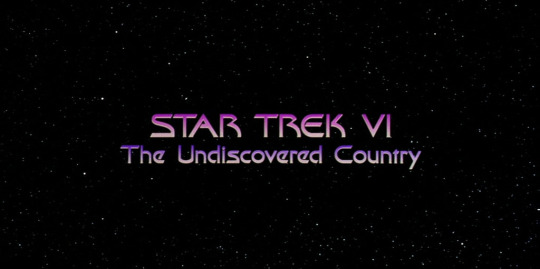
Spoilers Below
Have I seen it before: Yes
Did I like it then: Yes.
Do I remember it: Yes.
Did I see it in theaters: No.
Format: Blu-ray
1) This would be the last Star Trek film to feature the entirety of the original series cast (as it was followed by four films with the Next Generation cast and now the three films in the rebooted timeline) and is intended as such. Nicholas Meyers (director of Star Trek II: The Wrath of Khan) returns as director, Gene Rodenberry died just days after seeing a cut of the movie, and it seeks to give the original cast a fitting send off.
2) Even though it at times keeps his involvement in the plot minimal, I like that Sulu is Captain. It shows that there are officers who are as competent as Kirk and who seek to be more than just his inferior officers.

3) The opening of the film (where a mysterious wave knocks around Sulu’s ship only for it to be discovered to originate from parts of Klingon space) is an incredibly strong way of opening the film. It establishes the conflict and sense of mystery which will come to define the story.
4) Sassy Sulu is the best Sulu.
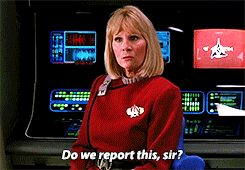
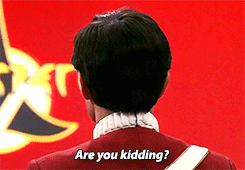
(GIF originally posted by @williamtriker)
5) I think deciding to end the stories of the original characters with a plot based around peace between Klingons and the federation is a great one. It pushes each of these characters into an alliance they are uncomfortable with. Klingons have been antagonists towards them since the original series, that’s 25 years at this point. And it forces all of them to examine things they are uncomfortable with, ESPECIALLY Kirk.
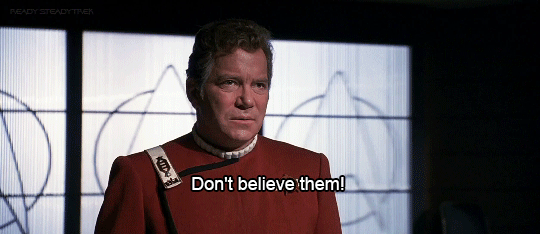
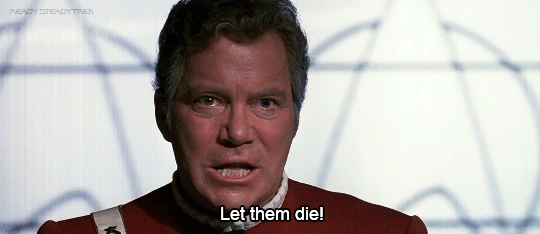
(GIFs originally posted by @readysteadytrek)
Kirk is obviously horrified and disgusted at the idea. He refers to the Klingons as admirals and calls Spock, “arrogant and presumptuous,” after learning he recommended him as a peace ambassador. How many times have Kirk and the Enterprise gone up against Klingons? How many times have they threatened them? And, most relevantly, what was the species of those who killed his son in Star Trek III? He is pushed into a place he never thought he’d be and never wanted to be. It is so much easier to vilify them and hate them than it is to work towards peace. But that is what Kirk has to do over the course of these two hours. Work towards peace. And that is an amazing conflict to see play out.
6) According to IMDb:
The film is largely an allegory about the fall of Soviet Communism. When General Chang demands that Kirk answer a question without waiting for the translation, it is an allusion to the real-life exchange at the United Nations between U.S. Ambassador Adlai Stevenson and Soviet Ambassador Valerian Zorin during the 1962 Cuban missile crisis. Also, the explosion on Praxis due to "insufficient safety measures" is akin to the meltdown at Chernobyl nuclear power plant in present-day Ukraine, which is believed to have contributed to the decline of the Soviet Union. Spock says that there was seventy years of "unremitting hostility" between the Klingon Empire and the Federation, which is not how long the Cold War lasted, but is the approximate length of time that the U.S.S.R. (Union of Soviet Socialist Republics) existed in the twentieth century, with a communist form of government.
That makes the conflict all the more ripe in may opinion & I love it all the more.
7) Kim Cattrall as Saavik Valeris
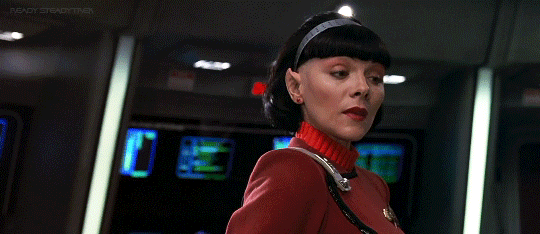
(GIF originally posted by @readysteadytrek)
According to IMDb:
Valeris was originally written to be Saavik, Spock's trainee from Star Trek II: The Wrath of Khan (1982), Star Trek III: The Search for Spock (1984) and Star Trek IV: The Voyage Home (1986) lending greater impact to her character's betrayal. However, Gene Roddenberry objected to the character's actions, ending up in a battle with Nicholas Meyer (who believed the Saavik character was his to do with as he pleased). Roddenberry won the dispute and the character was re-written into Valeris, who is played by Kim Cattrall. Cattrall wanted to play a different character rather than be the third incarnation of Saavik, following Kirstie Alley and Robin Curtis. Meyer had originally wanted Cattrall to play Saavik back in 1982, but she was unavailable.
I prefer that Cattrall is playing an original character. I don’t see it as being in line with what we’ve seen of Saavik in the past that she be a traitor and I think Cattrall is able to play a unique character because of it. Saavik - for me - will always be the somewhat proud closer-to-Kirk-than-Spock Vulcan in Wrath of Khan (as opposed to her more logical portrayal later on) so allowing Valeris to be her own character works. Cattrall is able to portray her as logical but with her own strong sense of morales and beliefs which leads her to some very interesting places/decisions by the film’s end. I think she’s a worthy character/actress to join the original crew on their final voyage.
8) Look how much Spock has grown!
Spock [to Valeris]: “Logic is the beginning of wisdom, not the end.”
9) I have to say the kinship Spock and Valeris are portrayed as having is done very well. Even though this is the first film she is in, we understand how and why Spock trusts/is proud of Valeris. This makes her betrayal by the film’s end all the more painful.
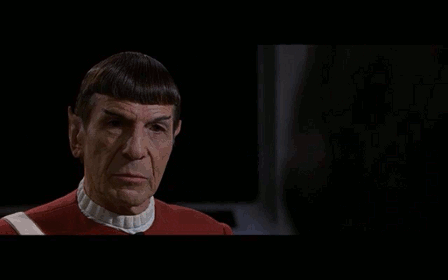
10) I can never get past the fact that Chancellor Gorkon is played by David Warner who was Sark in the original TRON.
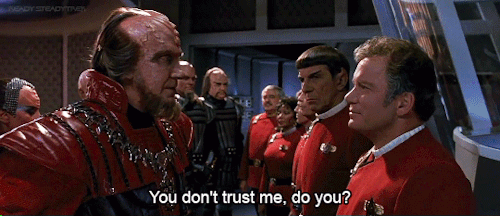
11) There are a lot of lines in this film which allude to the racism the Enterprise crew feels towards the Klingons.
Chekov: “Guess who’s coming to dinner.”
Nichelle Nichols’ Uhura originally had this line but the actress referred to say it. According to IMDb there was another line she refused to say which ended up being dropped from the film and that was, "Yeah, but would you let your daughter marry one of them?"
12) Christopher Plummer as General Chang.
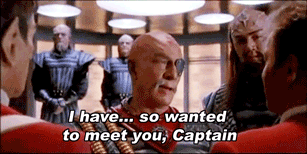
I truly enjoy Plummer’s performance as Chang and the character himself, although he runs out of steam a little bit by the film’s end. He is a poetic man, quoting Shakespeare often throughout the film, but a warrior through and through. A proud man who wishes to see the continuation of his race in what he believes is the best way (which isn’t necessarily the actual best way), Chang has an intense focus which Plummer performs well. A wonderful final villain for the original crew to face off against.
13) Remember how this film analyzes future bigotry?
Crew Member #1: “They all look alike.”
Crew Member #2: “And what about that smell? You know only top of the line models can even talk.”

(GIF source unknown [if this is your GIF please let me know].)
Also the filmmakers are doing a good job of drumming up sympathy for the Klingons right now. I am very much pro-Klingon in that moment.
13) The dinner scene.
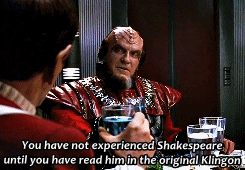
There are a lot of mixed emotions at play in this scene. Hope for the future - championed by Chancellor Gorkon - quickly turns into fear, distrust, and discomfort. It becomes apparent that most Klingons are not comfortable with this situation either.
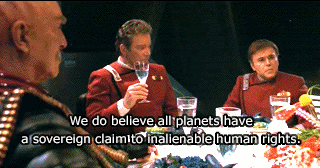
Azetbur [Gorkon’s daughter]: “ ‘Inalienable.’ If only you could hear yourself. ‘Human rights.’ The very name is racist.”
14) And the conspiracy begins.
Kirk [after the chancellor’s ship is fired upon]: “What happened.”
Spock: “We have fired on the chancellor’s ship.”
Honesty I think it is the conspiracy and mystery which makes this film as good as it is. It helps to set it apart from the epic which was Wrath of Khan or the more lighthearted fun if The Voyage Home. It plays out very akin to a Sherlock Holmes or Agatha Christie mystery and I am a sucker for a good mystery.”
15) Kirk may be struggling with peace but damn if he doesn’t immediately do the right thing.
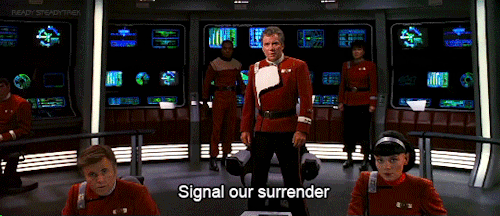
And then Bones - who is always a doctor first - goes with Kirk to tend to the wounded and tries to save the chancellor’s life. They put aside their fears and their prejudices in an attempt to do what’s right and I applaud them for doing so.
16) I don’t know why, but something about this exchange makes me smile.
Scotty [after the data is says they fired at the Klingons, even though all torpedoes are accounted for]: “No way!”
Spock: “I sympathize with you, Mr. Scott.”
I think it’s just Spock being Spock really.
17) Kurtwood Smith (of “That 70′s Show”) as the Federation President.
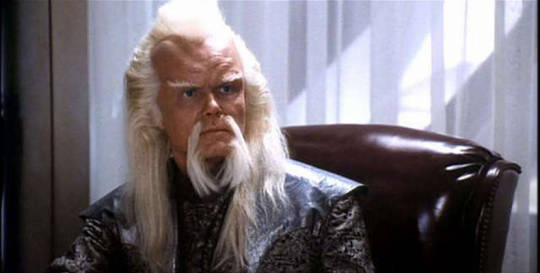
The nicest part about Smith’s character is that I found this line nicely refreshing:
“This president is not above the law.”

(GIF originally posted by @marshmallow-the-vampire-slayer)
18) The trial.
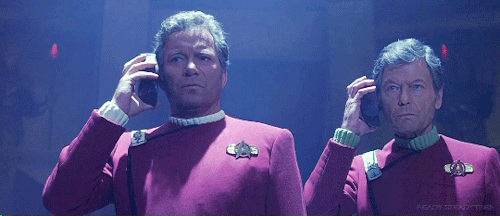
I think the trial of Kirk and Bones for the attack on the Klingon chancellor is the best part of this film. It makes you wildly uncomfortable the entire time, as it is meant to. While this film is an allegory for a post-Soviet-Union world, there is a lot of McCarthyism at work here. Their verdicts were clearly determined before they took the stands, with even Bones’ intentions as a doctor challenged.
Bones [after Chang accuses him of incompetence]: “I tried to save him [Gorkon]. I was desperate to save him.”
Bones has always been a doctor, so to accuse him of not doing his best to save a patient is such a painful strike to his soul. The scene also gives us this line from Kirk.
Kirk [after it is suggested some of his crew were the assassins]: “As captain I am responsible for the conduct of crew under my command.”
There is a difference between responsibility and culpability. There is a difference between responsibility and guilt. That is important to know.
18.1) Also we get this wonderful Michael Dorn cameo during the trial!
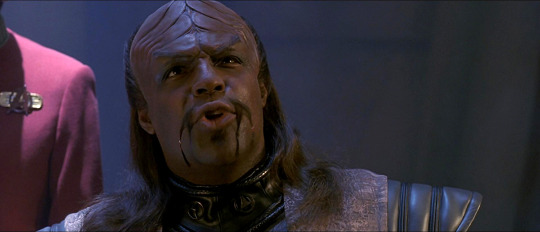
Dorn is most famous for playing fan favorite Commander Worf on “The Next Generation” which was already airing when he filmed this part as Kirk’s/Bones’ legal council in front of the Klingons. Although he is not credited as such in the film, it is understood that Dorn is playing Commander Worf’s ancestor Col. Worf here. I like the continuity, it’s a nice touch.
19) Ah, the connection between Spock and Sherlock Holmes.
Spock: “If you eliminate the impossible, whatever remains - however improbable - must be the truth.”
I love when Spock uses his logic skills in a Holmes-ian nature. Detective Spock is a lot of fun to watch.
20) The prison asteroid Kirk and Bones end up on I think is a great example of place in the film. It’s cold and desolate nature is an incredibly powerful atmosphere which conveys not only where theses characters are physically but emotionally by this part of the movie.
21) Expectations vs reality at its finest.
Spock: “If I know the captain, by this time he is deep into planning his escape.”
[Kirk is in a fistfight with another prisoner, trying not to get crushed.]
22)
Kirk [to Bones, in the prison, while they’re waiting for sleep]: “Are you afraid of the future?”
THIS is Kirk’s conflict right here. He’s TERRIFIED of the future and his place in it. It’s a conflict which goes all the way back to Wrath of Khan: he is afraid of being obsolete. Of the march of time. That’s what truly terrifies him and that’s what he has to deal with in this film.
23) Hey look, it’s Christian Slater!
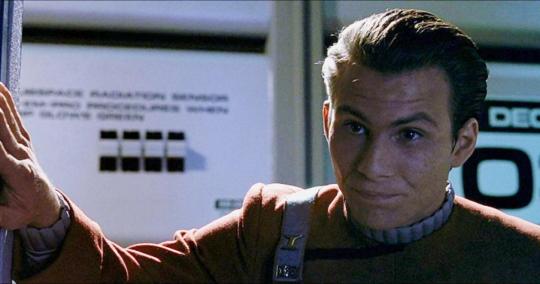
According to IMDb:
The Casting Director was Mary Jo Slater, mother of Christian Slater. Thus, his small role as a Communications Officer aboard the Excelsior.
Christian Slater wore the trousers made for William Shatner in Star Trek II: The Wrath of Khan (1982). "It was an honor to get into Shatner's pants", he quipped during a BBC interview.
Christian Slater framed his 750 dollar paycheck for his walk-on part.
24) According to IMDb:
Nichelle Nichols objected to the scene in which the crew desperately searches through old printed Klingonese translation dictionaries in order to speak the language without the standard universal translator being used. It seemed more logical to her that Uhura, being the ship's chief communications officer, would know the language of the Federation's main enemy, or at least have the appropriate information in the computer. However, Nicholas Meyer bluntly overruled her. In Star Trek (2009), Uhura specializes in xenolinguistics, intercepts and translates a Klingon communication, and speaks Klingonese in Star Trek Into Darkness (2013).
I agree with Nichols.
25) So in the prison Kirk makes out with a woman who turns out to be a shapeshifter, and when he learns she was a shapeshifter kind a recoils from her. Then she tries to kill him and Bones (which was her plan all along) and shifts into Kirk to cause confusion. Shatner seems to have a lot of fun playing the shapeshifter Kirk. It’s almost like he’s doing an impression of himself, dialing all the Shatner-isms up to 11. It’s brief but enjoyable.
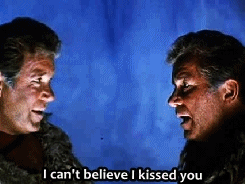
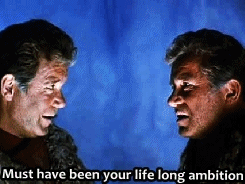
(GIF originally posted by @trekgate)
26) Damn, Spock is PISSED when it turns out Valeris is the traitor. He is hurting, and the mind meld he performs with her is super intense. It’s a nice side of the Vulcan I haven’t seen much of in Nimoy’s tenure as the character (Zachary Quinto would have some wonderful angry scenes though).
youtube
27) Dude, I love this.
Scotty: “Then we’re dead.”
[Beat.]
Spock: “I’ve been dead before.”
28) Spock and Kirk have one last heart to heart before the climax and resolution of this film and I appreciate that the film took the time to analyze their friendship one last time.
Kirk [while Spock is beating himself up over Valeris]: “Spock you want to know something? Everyone is human.”
Spock: “I find that remark offensive.”
29) The film creates some great climactic conflict by creating the dual scene of the Enterprise fighting off Chang’s ship and the nearing assassination at the peace conference. You know they can feasibly beat Chang, but do it in time to stop the assassination which gets dangerously close to fruition? THAT is the conflict. That’s the double jeopardy.
30) And this is the resolution of Kirk’s conflict with time.
Kirk [to Azetbur at the peace conference]: “People can be very frightened of change.”
Azetbur [realizing Kirk just saved the treaty signing]: “You’ve restored my father’s faith.”
Kirk: “And you’ve restored my son’s.”
Kirk has made his peace with the movement of time and is ready for its march.
31) Spock sass!
Spock [after the Enterprise is ordered to return to port to be decommissioned]: “If I were human, I believe my response would be, ‘go to hell.’ If I were human.”
Chekov: “Course heading, captain?”
Kirk [in his final line as captain of the Enterprise]: “Second star to the right, and straight on ‘til morning.”
32) Having the final credits for the main cast be their signatures is a nice touch.
youtube
When it comes to the original cast Star Trek films, Star Trek VI is second only to Wrath of Khan in my opinion. The added elements of conspiracy and mystery as well as themes of prejudice and bigotry help to set the film apart from the others. The characters are pushed to a place they’ve never been before personally and the entire cast shines in showing that. It’s a wonderful final film for the original stars after 25 years.
#Star Trek#Star Trek VI#Star Trek VI: The Undiscovered Country#William Shatner#Leonard Nimoy#Nichelle Nichols#George Takei#Epic Movie (Re)Watch#Christian Slater#Christopher Plummer#David Warner#Kim Cattrall#Michael Dorn#Kurtwood Smith#Movie#Film#GIF
52 notes
·
View notes
Text
In An Omni-Channel Technique, Who Gets The Attribution? Facebook Ads Supervisor Metrics vs. Google Analytics
"Among the most discouraging aspects of marketing today is over-attribution when comparing Facebook reports to Google reports.
Over-attribution is when you log into Facebook and it informs you it made you $100,000 in a period, then Google says it made you $100,000 because same period. $100,000 x 2 = $200,000, and you just received $125,000 worth of orders during that very same time duration."
This reporting circumstance that Meaghan Connell, CEO and co-founder of Praxis Metrics, shared has the capability to send out chills down many Facebook marketer's back.
It brings up the inevitable question, "Why does the attribution data in Facebook not match the information in Google Analytics?"It's not hard to explain the answer-- it's more that the answer isn't black-and-white, and can often raise more questions for digital online marketers and our clients.
Eventually, Facebook and Google are two contending services with their own exclusive tracking and are diametrically opposed.
Meaghan puts it finest:
"When it pertains to Facebook versus Google tracking and reporting, there are a couple of things you have to understand:
Although the 2 platforms integrate with each other, each is completely separate. They have various objectives, definitions, standards, and capabilities for tracking.
Each platform just owns their own information. That indicates, when you enter into the reporting elements of Google Advertisements or Facebook, you will naturally have actually mathematically prejudiced information. Each platform only sees one variable (their ads) as an influence on your sales. Nevertheless, there are always several variables involved-- multi-channel marketing, public relations, organic posts ... even the weather and political climate may possibly affect your sales.
When you log in and see differing information, it's not that they are attempting to be dishonest, it's that they are just presenting you their side of the story.
Anyone who's ever been in a relationship understands that there is your side of the story, their side of the story, and the truth, which is someplace in the middle. When it comes to Facebook and Google reporting, neither is lying, it's just that neither is revealing you the entire photo due to the fact that they both are naturally prejudiced."
Precisely.
I can't inform you how many discussions and analytics sessions I've had with my mate, Jason Linde, EFFECT's resident Google Ads strategist, on this topic:
"Many of the time I see customers make use of Google Analytics unpacked 'as-is,' not fully understanding that it depends on them to feed Google Analytics information back that helps the platform to much better comprehend their particular organisation model," said Jason. "This indicates that both clients and firms need to work together on setting objectives, removing bad data and discovering that attribution design that best fits their buyer's journey. If you are not filtering your funnel to what matters most, then what are you optimizing for?"
Provided this is a hot button for numerous of my mentors and peers throughout the Facebook, Instagram, and Google Ads universe, I thought it would be fascinating to get their take on the matter too.
Let's begin at the beginning-- Facebook and Google Analytics Are Competitors
They both have ad area to offer you and they both want you to believe their platform provides one of the most return.
Now, this isn't the reason that the metrics are various, but it is the reason we will never see the platforms have cohesive reports.
One of my colleagues, Jason Portnoy (who has a great podcast with a who's who lineup of the digital marketing world), described:
"You'll never ever fix up the two until both platforms merge reporting (which will never ever happen). You can get close, however [they'll] never ever be 100% precise and similar. I have actually gone through in this manner more times than required. I've spoken to some of the leading Facebook online marketers and some of the leading Google online marketers, and both sides say the same."
Both platforms wish to paint themselves in the most positive light and with good reason.
Both have their benefits and can provide outcomes.
"If the client is running display screen [Google Ads] and Facebook [Advertisements], Google tracking becomes important," stated Curt Maly, among my coaches and co-founder of Black Box Social Network.
"If your goal is to generate straight-up customers, top-of-funnel, with little to no retargeting ... I would go off of Facebook statistics. If there is a great deal of traffic that is warm that I'm retargeting (including their e-mail lists)... I'll desire to compare Facebook tracking and Google."
Keep in mind, Curt stated "compare"-- not use one over the other.
In other words, we require to take a look at both to quickly see what's working, what's not, and where to put more spending plan.
We're All In This Together
Often, there is a lot information for you to sort through, you can feel paralyzed. Understanding what to monitor and where to get the details from is no simple task.
The whole digital marketing environment requires to collaborate as a single buyer's journey is rarely one-touch; it usually consists of campaigns or material from a range of sources. (More on that in a second.)
Attempting to nail down the specific credit or attribution for a specific channel in an omni-channel marketing effort like this is not only very difficult, but can lead to some really bad decision-making.
In Google Analytics, you will constantly see substantially less purchases attributed to any channel that is not exclusive to Google.
If you stop running your Facebook Ads, you'll see a drop in organic search and direct conversions.
Likewise, while you can't see purchases from other channels in Facebook Ads Supervisor, if you stop running your Google Ads you'll see your Facebook purchases go down.
"Eventually if you are getting an appropriate cost per acquisition, I like to look at it as an integrated marketing effort resulting in a desired outcome, not 'Facebook gets this much credit and Google that much,'" stated Alex Afterman, Facebook Ads coach and trainer for CatHowell.com, and owner of 11:11 Digital.
That makes good sense-- all of it collaborate to result in the sale.
This is in fact shown with Top Conversion Courses in Google Analytics. Here's an example that reveals exactly what Alex implies:
As you can see, there was no single factor that result in the sale; it was a team effort. Alex continues "... ROAS(Return on Advertisement Invest )looks at attribution for private transactions and customer acquisition. So, if you think about the LTV (Lifetime Value) of your consumers, Facebook and Google-- and any of your prospecting channels-- are getting substantially less income credited to them than they are really producing for your business."
In other words, that conversion course example above is probably ONLY going to associate the actual sale to the last click, which is why it can be so destructive to make budgeting decisions without the complete picture.
We need to not take a particular metric from anywhere at face-value without thinking of the total objectives and health of organisation.
Isolated, one-sided information will be the death of growth, and potentially of services.
Let's Talk About Last Click ...
I want you to think of your own individual online purchasing habits.
When is the last time you discovered a brand name and quickly bought from it?I'm guessing never.
I know I haven't. And, obviously, I'm not alone.
A 2018 Inc. short article highlighted that "a study from Episerver showed that most transactions don't take place during an initial visit to a site. According to their report, nine out of 10 (92%) customers visit a brand's site for the very first time to do something besides purchase."
Let's explore this a bit more.
I am a self-confessed shopaholic and, I can inform you, I never purchase immediately. Here's a quick example:
Me [scrolling through Instagram]: Oh, that t-shirt is so adorable. It would look so great on my 10-year-old.
10-Year-Old: Mama, can you assist me reach the cups?
Me: Yeah, one minute. Let me simply add this yellow t-shirt to the cart.
* crash *
Me: ... what was that?!
10-Year-Old: Oops! I was so thirsty, I may have inadvertently, sort of, maybe overturned every cup in the cabinet.
Me: ...
An hour later.
Me: I need to end up a report. Let me see if I got the information I needed.
Open email.
* chime *
Me: Oh, I need to donate to my pal's cause on Facebook. I'm happy I got that suggestion on Messenger recently. Oh wait, there's that yellow shirt! I have to keep in mind to get that! Let me produce an account and make sure I put it in my cart again.
* shouting *
10-Year-Old: The pet dog got out !! Help me, mom!
Me to myself: $%^&& * #)
Me outloud: Okay honey, coming!
The next day.
Me: Time to grab coffee, check e-mail and get moving! Oh! There's that yellow t-shirt once again! And now it's in my inbox! With a discount! Let me get that for my 10-year-old now.
... I purchase the yellow shirt.
BUT WAIT-- Which platform gets credit for the sale?
The Instagram advertisement? The Messenger advertisement on Facebook? Or the e-mail?
In situations like this, the majority of programs (i.e. Google Analytics) default to what's called "last click."
In this lovely regular purchasing situation for my household, email gets the win.
"You're measuring off of 'they clicked and they transformed,' which is not always properly to do it, in my viewpoint," Andrew Foxwell, and co-founder of Foxwell Digital where he has actually dealt with the similarity KIND Snacks, Hilton, The Grand Ole Opry, Blenders Eyewear, Pura Vida Bracelets, said during among his podcasts.
"That can be challenging when you are taking a look at your budgeting. If you're looking simply at last click, you're going to be dedicating more resources to the places where there's less friction towards completion of the funnel, but possibly not crediting enough of the top of the funnel, where you're really opening and generating new individuals."
To put it simply, you'll be making ad spend decisions based upon data that does not tell the whole story.
There needs to be a much better way to understand attribution, right?
Well, excellent news-- there is.
(Side note: is one of my go-to resources and I extremely advise you add it to your must-listen to list.)
Really Comprehending Attribution Data
Meaghan Connell dug deeper into comprehending attribution for me as well:
"There is a lots of data readily available to you. But data alone will not grow your service," Meaghan began. "It's the understanding from the information that will inform your group on how to grow. Business that concentrate on causation will scale. Those that do not, will stop working."
Simply put, Meaghan is saying that acting from information is the brand-new competitive benefit.
As she rolled up her sleeves (actually and figuratively), I understood I was about to get some juicy viewpoint):
"There are two actions to get accurate reporting on your marketing efforts in your systems.
# 1: Tracking
Get as much info as possible. Info is merely numerous points of data brought together to permit you to see patterns and acquire answers to questions, like:
How much overlap do we have in reporting?
Exist customers that have been exposed to multiple marketing efforts?
If so, are we connecting together their consumer journey with accurate tracking efforts?
What are all the possible influence on our sales?
How have they affected sales before?
Exist connections?
How are you going to respond to these concerns to get the insights you want? You must have the data in order to have the ability to evaluate the information to get insight.
That means, tracking is the first and main component of precision in your reporting:
Are you tracking your customer's journey?
Do you have organized UTMs setup?
Are you utilizing pixels?
Do you have special identifiers for your customers that enable you to see their client journey?
If not, that's your first goal.
Start organizing your tracking efforts so that you can begin gathering the data you will require in the future.
# 2: Reporting
When you have tracking in location, you can usually manually develop Excel reports that provide you a much more accurate representation of your marketing efforts (consisting of lift impacts and other variables). Over time, that becomes tiresome and time consuming and permits for too much human error.
The next logical action is to automate via ETL (drawing out, transforming, and packing the details from these systems into a particular location) and after that to picture the integrated, clean information with a control panel.
This allows you to eliminate squandered time, effort, and offer you insights in a quick and digestible manner."
My brain injures a little. And I enjoy information. Thankfully, she graciously shared an extensive video about info optimization so she can explain it much more:
So, What Now?
I asked Meaghan if it's helpless. Will attribution ever truly be clear?
"Everybody has different backgrounds and experience, so when they take a look at a metric they will see one thing and develop an action product based off their experience; however if you bring in another set of eyes, that person might see something completely different and concern a various conclusion," she responded.
It was a little disconcerting to hear it was so subjective, however then she gave me hope:
"Equalizing data and making it accessible to more individuals will cause higher insights and more options for ways to proceed."
Basically, don't analyze in a vacuum. Acknowledge and appreciate the other perspectives so that you can have a collaborative technique.
Plainly, there's no scarcity of viewpoints on attribution, and as Meaghan pointed out, data will constantly be prejudiced within its own channel.
Eventually the objective is comprehending the true consumer's purchase journey to determine the most effective marketing channels for investment ... and, in turn, service development.
Instead of searching for a single, clear cut answer to the question of Facebook Ads Manager metrics or Google Analytics, you require to embrace a more holistic method to attribution. Work with your group and set clear objectives from the outset of your campaigns.
And, when it's all over, never ever rely on a single channel to inform you the whole story.
This content was originally published here.
0 notes
Text
On Choreography
I’d like to reflect in this post on my experience learning African Music and Dance. I should start by saying that “African Music and Dance” might be misnomer for the course I took in Ghana, since I’m pretty sure the three dances we learned were regionally Ghanaian (though potentially dances from various nations located in Ghana). Prior to starting the class, I had a bit of experience with choreographed dancing—dancing that required little to no “connection” to the music and which could be performed strictly on a count (usually 1-8) with or without music. This class was decidedly not the same thing, as it required that we learn what our professor called “the drum language.”
We were introduced to the concept of a drum language in our orientation for the program with USAC when we arrived in Ghana, but no one ever explained what that meant. My experience in my dance class demonstrated that the drum language was something that one should treat like any other language: it requires listening and responding (often critically), which leads to and eventually requires a level of fluency. These dances were not choreographed in the same way I was used to. While there are standard movement sequences associated with specific drum beats, the dance could look different every time it is performed. In fact, though we learned three dances, I know for a fact that they looked different each time we performed them, and this is due specifically to the nature of the drum language and the relationship between the drummers and the dancers.
One of the first things our professor explained to us was that dancers are, to maintain the language metaphor, dually-fluent. What that means is that dancers have to know both the drum beats (our professor, a professional dancer and choreographer, actually drummed during our performance) and the dances. Drummers, on the other hand, are only required to know the drum beats (though it was clear that they knew, visually, what dancers should be doing at any given moment). When we were learning the choreography for each of the dances, the first thing we were asked to do was to verbally repeat a drum beat (for example, gerebeng) and then to learn the movement sequence that went along with that beat (for gerebeng, it was a walking step in which we lifted the right leg in a sort of high-knee style, skipped on the left foot, and swung the right arm in around in sequence with the right leg). We would learn several of these beat/sequence pairs and then we would learn drum cues, which were the beats that told us which sequence to switch to. I’ve been told that this process is similar to “leading” in ballroom dancing, in which the leading dancer performs subtle cues to indicate when something will happen, like a dip. I’ve never learned ballroom dancing before, but I figured the comparison might help.
What I learned from this form of choreography was that I had never really heard or listened to the music I danced to, not really. I hear people all the time talk about “feeling” the music, and as someone who has studied affect theory before, I thought for sure that I knew what that meant. But even when I knew the drum language, I still depended on habits I formed from count-based choreography. One specific habit was common amongst me and my peers, and that was that we expected specific sequences to last for a determined (and finite) amount of time, but the nature of the drum language dictates that you listen to what the drummer is telling you. If, and I quote, “the drummer wants to play that sequence for two hours, then you have to dance to that sequence for two hours.” This distinction between count-based and language-based choreography produces the effect of a “different” dance each time it’s performed. Dancing based on the drum language means that your dance won’t look exactly the same each time, though it will have the same basic components. I’ve included a recorded version of our third dance, Koto je, but I do want to emphasize that even a recording of a dance (an archive?) undercuts the point I’m trying to make, which is that the dance is by nature different every time.
https://youtu.be/bQPF9gH1Ygw
I emphasize this point because it is the nature of storytelling in Ghana (and across African nations) as well. The oral tradition of storytelling is “choreographed” in a manner similar to the dances we learned: there are basic component parts (which can be found in transcribed versions of the stories, like those in Tales of Amadou Koumba translated and transcribed by Birago Diop) which instigate a communal lesson-teaching session. Different parts of the story are meant to provoke questions, comments, responses from the audience, and the storyteller is meant to respond to those. This process produces a different story and storytelling experience every time, and potentially teaches different—if adjacent—lessons.
I say all of this (which is a lot) to say that I think these experiences with African Music and Dance and Literature have taught me a lot about what people mean when they say that you should be teaching the students in front of you. Education—in praxis, in real time—is less about the choreography (which is important in that it keeps you on track for what you want students to learn) and more about how the students respond to that choreography (for instance, whether or not someone might need to rehash something in order to move on, or if a more poignant or imperative topic is weighing on students’ minds at any given moment). I’m not sure I could concretely tell you (yet) how this changes my work and habits, but I know I’ll be giving it all some serious consideration in the future.
I’ve been back for a few days, so next post is all about re-entry! In the meantime, enjoy these photos of my dance class!
~LC


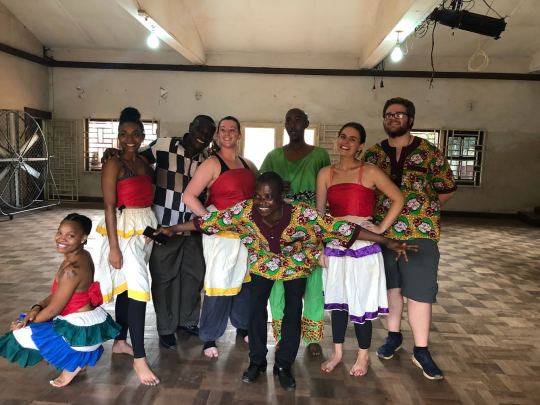


#Study Abroad#Free Range Gamecock#Ghana#African Music and Dance#african literature#Choreography#Dancing
0 notes
Text
Harm Reduction & Comfortable Trips
Psychedelic Praxis Guide to Harm Reduction & Comfortable Trips
The focus of this document is on the responsible and informed use of mind-altering substances. In this vein, we strongly advise that users use harm reduction measures and intentionally plan their set and setting in advance.
Thanks to /u/brainbanged for doing the bulk of the work formatting this document as plaintext, and for the Reddit community for making many contributions. These submissions come from the /r/PsychedelicPraxis community.
Set & Setting
If you are planning to use psychedelic drugs for the first time, we strongly advise that you do some general reading about how to prepare for a safe and productive trip.
Besides the actual chemical contents going into your body, the psychedelic is equally affected by one's surroundings and emotional experience. Set refers to personal preperation, including both one's personal history and their emotional state at the time of the trip. Setting refers to the physical surroundings: environments, sounds, other people, cultural icons, and anything else one perceives.
In order to prepare for a positive and productive trip, it is helpful to read about how people respond to different drugs under various circumstances, and try to intentionally construct a set and setting that feel comfortable and catered to you on the day of your trip. Here are some resources that provide helpful information on how to prepare yourself for a trip:
Trip Guides Online
Bad Trip Guide
How to Use Psychedelics
Session Games People Play: A Manual for the Use of LSD
Handbook for the Therapeutic Use of LSD: Individual and Group Procedures
The Psychedelic Explorer's Guide (book)
For information on the individual substances you are consuming or may be considering consuming, be sure to also visit:
PsychonautWiki Substances Index
Erowid Psychoactives Vault
Effect Index
Harm Reduction
Some illustrated advice from Zendo Project on how to be a good tripsitter/how to be present during a trip, for those of you looking for a quick lesson.
Zendo Tripsit Card
Other information via Psychsitter and DanceSafe:
Trends in Harm Reduction interview with DanceSafe
The Manual of Psychedelic Support 2nd Edition
Medication and Drug Interactions
If you are on any medication taken regularly, especially if you are taking antidepressants or other psychiatric drugs including lithium or MAOIs, be sure to spend time researching and known interactions with any psychedelics or empathogens you plan on taking. Search forum posts and read what others have experienced under similar chemical combinations.
Be sure to check your Tripsit's drug interaction page, which contains the following chart of great utility, as well as futher information on interactions:
Tripsit Guide to Drug Combinations (also see here)
Hobbyist breakdown regarding the effects of SSRIs, MAOIs and RIMAs on serotonergic psychedelics:
Related studies:
Chronic Administration of Serotonergic Antidepressants Attenuates the Subjective Effects of LSD in Humans (1996)
Alterations in responses to LSD in humans associated with chronic administration of tricyclic antidepressants, monoamine oxidase inhibitors or lithium (1996)
HPPD and PTSD
The intense mental effects of psychedelics can bring on a set of symptoms known as Hallucinogen Persisting Perceptual Disorder (HPPD), and overwhelming psychedelic experiences can also induce Post-Traumatic Stress Disorder (PTSD); it is not unusual for these conditions to occur in tandem.
HPPD can be recognized by persistent visual distortions while sober including visual static, increased tracers or afterimages, confusion over color perception or identification, bright or dark halos around objects of visual focus, size and perspective distortion, and many other features.
PTSD may emerge from traumatizing or unintegrated experiences had under the influence of psychedelics. These experiences may also be tied up in HPPD perceptions, which can make life very uncomfortable.
Most sufferrers of HPPD find it subsides within a few months of abstinence from psychedelics. For more information on managing these symptoms, refer to the following:
Erowid HPPD FAQ
HPPD Online Forum
/r/HPPD/
If you are overwhelmed by past psychedelic experience or suspect you may be developing symptoms of PTSD as a result of them, refer to MAPS's Integration List of therapists who practice psychedelic integration:
MAPS Psychedelic Integration List
Informed Dosage
It always helps to know the dosage and effect of chemicals before you take them. Always ask your source if they know the dosage drugs you acquire, and if possible ask others who have already tripped on it what their impressions were.
If you are taking a substance for the first time, start by taking a low dose to test its effects on your psyche and physiology before delving more deeply. Suggested dosages are available on these websites:
Unfortunately, we often end up with drugs of unknown or degrated quality, and without an effective means of testing their effects before taking them. If you do not know the dosage of your drug (but are sure of what substance it contains), test it by taking a small quantity of what appears to be a single intended dose.
If you are taking chemicals that come as a powder or crystal, buy a milligram scale. Do not attempt to approximate milligram quantities by eyeballing them.
Bluelight Survey-Obtained Psychedelic Tolerance Curve
This plot was generated using anecdotal user reports via Bluelight. Source: The Big & Dandy LSD & Shroom Tolerance FAQ and Discussion Thread
Here is a version of the curve based on a slightly more nuanced interpretation of the data, made by Mx. Rylee Fox:
Drug Testing
When ingesting mind-altering chemicals, it is critical to test their contents, especially if they were acquired from a new or unreliable source. This can be done simply using a reagent kit, available from the trusted below:
DanceSafe (US)
Reagent-Tests (UK)
EZ Test (NL, worldwide shipping)
Below are some color identification charts for various reagent kits and chemicals of popular interest:
DanceSafe Reagent Test Identification Chart
Drugs Forum Reagent Identifications
DanceSafe Fentanyl test strips
Please test substances for fentanyl!
Obtaining Narcan
Narcan, a nasal spray which counteracts the effects of opioid overdose, is available without a prescription in most US states. Like an Epipen, carrying Narcan can help prepare you for the worst-case scenario. For a two-dose package, Narcan costs between $40-$150 depending on where it is available, and may be covered by insurance.
General information and Walgreens/CVS distribution
Additional CVS availability
Retail pricing information
Reagent Reaction Videos
Bunk Police Android App contains HD reagent reaction videos for reference when testing substances:
Bunk Police
MDMA Identification
Due to being one of the most adulterated drugs, the impurity of MDMA (also known as molly, mandy, and ecstacy) in different regions and at different times varies. According to data collected from a range of sources, anywhere between 30% and 60% of what is being sold as molly or ecstasy in the USA is not in fact MDMA. While MDMA purity is generally higher in Europe, adulterants do still appear. Substances such as synthetic cathinones (methylone, butylone, MDPV, ethylone, etc.), ketamine, amphetamine, methamphetamine, PMA or PMMA, alpha-Pyrrolidinovalerophenone (known as flakka), DXM, and even heroin or fentanyl have been found in supposed MDMA pills. There are also less controversial ingredients such as aspirin and caffeine, as well as inert binding agents.
In addition to proper reagent testing of pressed pills, please visit Ecstacy Data for lab tests and Pill Reports for subjective user reports.
MDMA Safety
While MDMA has therapeautic and recreational value, neurotoxicity has been shown in lab animals as a result of high and frequent dosing. There is no substitute for moderation. Doses should ideally be spaced 3 months apart, but at least 6 weeks as a general rule. Persistent use is linked to depression, suicidal ideation, sleep paralysis, and other side effects.
An issue with MDMA is its ability to raise body tempurature. It is important to take frequent breaks from physical activity to cool off while under the influence.
Another issue is water retention and the associated decreased salinity of the blood. During the roll, you may notice that you have difficulty peeing or experience cranial pressure. You may feel very thirsty and dry-mouthed, and it is important to stay hydrated, but drink no more than 1-2 glasses of water per hour. Drinking beverages with electrolytes or isotonic (salty) fluids will reduce the risk of hyponatremia, especially in women. Drinking alcohol is not recommended as it dehydrates you, depletes electrolytes, dulls the stimulating effects of the MDMA, and can increase the risk of blackouts & hangovers.
Magnesium is often taken to reduce jaw clenching/"gurning" and reduce nausea. There are a variety of types of magnesium with different degrees of bioavailability, with glycinate/chelate as the most recommended. Antacids and natural remedies such as ginger may also be taken to reduce nausea.
Many users suggest pre-loading and post-loading with neuroprotective antioxidant supplements such as Alpha Lipoic Acid (ALA), Acetyl-L-carnitine (ALCAR), Ascorbate (Vitamin C), Vitamin E, Nicotinamide, Ubiquinone (Co-Q10), grape seed extract, and green tea extract (EGCG). It is also recommended to take 5-HTP (with vitamin B6) to help promote the replacement of endogenous serotonin after a roll. More information can be found at:
https://www.youtube.com/watch?v=FlMxTpONKT0
https://rollsafe.org/
https://dancesafe.org/ecstasy/.
As seen in the tripsit.me drug combinations chart, cannabis has a low risk and high synergy with MDMA, but anecdotal reports suggest increased headspace at higher doses, and caution should be used considering the tendency of other substances to be sold as MDMA. MAOIs should not be taken with MDMA, due to the increased risk of the potentially fatal serotonin syndrome. SSRIs will typically reduce the effects of MDMA, SNRIs may change effects, and TCAs will generally increase the effects at unknown levels. Some users report utilizing SSRIs after a roll to stop the flood of serotonin and reduce neurotoxicity.
MDMA also lowers the seizure threshold so proceed with extreme caution if you have a history of seizures. Studies have shown that MDMA interferes with one's ability to discern negative emotion from facial expression. While fear reduction is great for therapy and having a good time, take care in unfamiliar places and with strangers. You don't want to be taken advantage of!
Psilocybin Mushroom Species Potency Guide
Different mushroom species can vary in potency. Even among the same species, actual psilocybin content may vary. For more information visit:
http://www.shroomery.org/
https://i.imgur.com/Dr6lvrQ.jpg
Smoked Cannabis vs Edibles
"The base pharma- cokinetic equivalency ratio is 1 to 5.71. This means that one milligram of THC in edible form, is equivalent to 5.71 milligrams of THC in smokable form." (https://www.colorado.gov/pacific/sites/default/files/MED%20Equivalency_Final%2008102015.pdf)
Leafly Cannabis Strain Explorer
Leafly's index has information on many strains of cannabis, and includes subjective effects for each entry as well as a cannabinoid profile.
https://www.leafly.com/explore
Example: Girl Scout Cookies Strain Profile https://i.imgur.com/lQBelOt.png
Cannabinoid Profiles
Information regarding various parts of the cannabis plant continues to grow. As you may be aware, CBD has little to no psychoactive component and can be used to treat pain and anxiety. Other calming cannabinoids are CBN and CBG. THCV is energetic and shows promise as an appetite suppressant. Below are a variety of uses of different cannabinoids, which unfortunately remain unevaluated by drug regulating agencies due to a prohibition on research.
Cannabinoids chart 1 https://i.imgur.com/bblfuUR.jpg
Cannabinoids chart 2 https://i.imgur.com/eZe4E0z.jpg
Additional infographics: https://cosmosmagazine.com/biology/infographic-how-cannabis-works
Cannabinoid Vaporization Temperatures
Here are the boiling points of several compounds found in cannabis.
Study from 2001 by McPartland & Russo
Vaporization temperature chart
Preliminary Analysis of FDA’s 36 Kratom-related Deaths
This is a breakdown of the causes of the kratom deaths that the FDA has used to justify its stance to heavily regulate the drug. There appears to be a number of novel drugs combinations implicated in these deaths, and it is recommend reading for anyone who wishes to understand the problem further.
https://www.dropbox.com/sh/nqukey9pdllwb1y/AADMawszBzHB5kCryxVwAMiYa?dl=0
Additional documents linked from the analysis:
https://docs.google.com/document/d/13Ii9JrRR0hbVNVFTqvgET7jetqhgiBQe58BoYNddAFY/edit
https://docs.google.com/spreadsheets/d/1lbzT5LKkV1tOxxkXw_ZYhqFjuzb7njmxTtf4iH2Fuz4/edit#gid=0
DXM Dosage Calculator
These web tools that takes your weight and spits out appropriate dosages for the different "plateaus" of DXM.
DXM Calculator at Tripsit
DXMcalc
Benzodiazepine Converter
This is a simple calculator made to help you figure out how much a given benzodiazepine converts to another benzodiazepine dosage.
Benzo converter at Tripsit
Dissociative Anesthetics
There have been recent reports of O-PCE being sold as DCK, with 2 samples confirmed in lab last month (https://twitter.com/hamiltonmorris/status/951524523966451713?s=21). There are now reports of potentially lethal PCC appearing in large quantities in batches of 3-MeO-PCP (https://www.reddit.com/r/RCSources/comments/81e0l7/warning_potential_lethal_batch_of_3meopcp_going/). This is not a new phenomenon given that PCC is a precursor (https://erowid.org/archive/rhodium/chemistry/pcp.pcc.analysis.html) but it is something to look out for. One suggestion is to test with steel wool and hydrochloric acid and look for a dark blue reaction (http://bluelight.org/vb/threads/649827-PCP-to-PCC).
The Secret-Alchemist Club Anti-Nausea Shot
An anti-nausea solution which was highly recommended by a community member.
Secret-Alchemist Club Anti-Nausea Shot
=========== Microdosing
A variety of resources on microdosing LSD and mushrooms, including a paid course and access to a private community, are available at the third wave.
Participants in the Fadiman/Korb microdosing study (https://sites.google.com/view/microdosingpsychedelics/home), using LSD, 1p-LSD, or mushrooms, have reported using certain medications and supplements with no adverse response. If you are looking for a medication or supplement of interest, we recommend using CTRL+F to find it. https://sites.google.com/view/microdosingpsychedelics/drugs-and-supplements
Dr. Dave Nichols talks about the potential downsides of microdosing, including cardiac valvulopathy, on this Psychedelic Salon podcast: https://psychedelicsalon.com/salon2-034-psychedelic-chemistry/. Concern arises from activity with the 5HT-2B receptor as indicated in the research paper "Serotonin Receptors and Heart Valve Disease – it was meant 2B" (2011):
0 notes
Text
Binge Dramaturgy: Joel Baxendale @ Edfringe 2017
BINGE CULTURE and ZANETTI PRODUCTIONS presents
ANCIENT SHRINES AND HALF TRUTHS
WHALES
BREAK UP (WE NEED TO TALK)
Performance alchemists Binge Culture are a New Zealand based group of artists who are working to renew theatre for the information age by giving spectators real stakes in their experiences.
Binge Culture are bringing a suite of three shows to the Edinburgh Festival Fringe in 2017: Ancient Shrines and Half Truths, Whales and Break Up (We Need To Talk).
What if you could step through a ‘digital looking glass’ and encounter your city as if for the first time? Binge Culture’s Ancient Shrines and Half Truths is an immersive outdoor audio-based theatrical experience which invites the audience to explore a seemingly innocuous urban area as a privileged outsider.
Based on a simple user-triggered app interface participants take the role of travellers seeking to ‘belong everywhere’, exploring a park and pursuing authentic experiences (before they become too popular). Each traveller carries an audio device through which they are guided by a cultural insider. Real world elements, binaural soundscapes, actors, and objects installed around town intersect with the narration to blur the line between fiction and reality.
In development for two years and premiering in Edinburgh, this show is a truly unique experience - a cross between En Route, Sleep No More and The Hitchhiker’s Guide to the Galaxy. The adventure starts at Summerhall, but who knows where your journey will take you.
The second offering from Binge Culture is Whales, a community-building street performance which enlists the help of bystanders. Each year, around 300 dolphins and whales are stranded on New Zealand’s shores, which brings entire communities out onto the beach in question to keep them cool, wet, and when the tide returns, help send them back into the sea.
Binge Culture’s Whales will see a pod of local volunteers migrating through the inner-city streets of Edinburgh, and beach at George Square Gardens. Under the guidance of the Binge Culture Response Team, audience and bystanders will be tasked with saving the whales.
Break Up (We Need to Talk) is five hours of desperation, negotiation and emotional blackmail, improvised non-stop by five performers playing two characters having one very difficult conversation. Dressed in banana suits, the durational aspect of the performance soon takes its toll, with the consequence of exhaustion and miscommunication lending itself to hilarious and often unnervingly real moments of frustration and relationship manoeuvring.
Spectators can come and go from this event throughout the evening – or stay until everything is worked through, and are invited to live tweet commentary to #bingebreakup.
Those who can’t make it to the theatre can follow the anguish on Twitter. Break Up first premiered in NZ Fringe 2014.
ANCIENT SHRINES AND HALF TRUTHS
Venue: Summerhall. Meet in the Courtyard. Prices: £8-£11
Dates: 2-27 August Time: 15.15 & 18.15 Duration: 60mins
WHALES
Venue: Assembly George Square Theatre Prices: FREE
Dates: 5&6, 12&13, 19&20 August Time: 12.30pm Duration: 45mins
BREAK UP (WE NEED TO TALK)
Venue: Summerhall Basement Prices: £8-£10
Dates: Monday 7, 14 & 21 August Time: 18.00pm
Ancient Shrines and Half Truths
What was the inspiration for this performance?
AirBnB is a big inspiration for the show. Their
slogan ‘Belong Anywhere’ encapsulates the sense of entitlement supposedly woke global travellers tend to exhibit.
This idea that you deserve to be able consume someone else’s culture with impunity with total disregard for how this impacts actual locals and as opposed to the 5 minute locals these travellers love to imagine themselves as.
So it’s a show about the commodification of authentic experiences and of the desire to consume these experiences before they become too popular or touristy. But it’s also a celebration of independent travel, of looking under the surface of a city and finding the minuscule and bizarre details that really make places what they are. So it’s a gentle satire of good intentions being captured by capitalism and consumerism that owes a lot to Hitchhikers Guide and Discworld series in terms of its quietly absurdist subversive tone.
Is performance still a good space for the public discussion of ideas? It’s still the best space to be be surprised in - nothing beats live surprise. Performance can be incredibly visceral, so much information communicated through all the different senses, and enormous ideas can be grappled with in a relatively short space of time. Then there’s the social aspect that helps people to open up, the shared space that allow us to experience things more acutely. So absolutely it can be a great space for public discussion of ideas, and while it may be less widely distributed it’s certainly more concentrated.
How did you become interested in making performance? We have very many influences. However, like many other groups we were originally inspired by the work of Forced Entertainment. Their sense of playfulness and anarchy are lovely, and use of non-narrative structures, eye-opening. Most importantly they inspired us to rethink the relationship with the audience. Once we started experimenting with this, we realised that there are really no limits to the ways you can give the audience real stakes in a performance.
Is there any particular approach to the making of the show? Like all of our shows Ancient Shrines is devised, although this process is a little different because to put yourself in the place of the audience during an improvisation is to be bang smack in the middle of it. The people improvising have control over what you hear, but you have complete control over what you do physically, but you need to try to react ‘honestly’ but also be aware how other people might react. So figuring out what material to select is not at all straightforward, and of course there’s a lot of logistics around how we shape the experience.
Does the show fit with your usual productions?
All our work interrogates the role the audience has to play, and we are always use humour to investigate serious subjects and try to be playful with that, so in those respects this show fits in completely (I think). In terms of form, Audio based work forms one of the strands of our work as a company. We also make shows for traditional theatre spaces (in, I guess, what you could call a post-dramatic style) as well outdoor and interactive performances. In some ways Ancient Shrines is actually a meeting of these three strands.
What do you hope that the audience will experience? We hope that the audience will be empowered by their sense of agency during the show, and then because of that feel more complicity as the show goes on. If people catch themselves doing daft things in public and laughing about it, then I’ll be happy.
What strategies did you consider towards shaping this audience experience?
We have been making ‘unauthorised audio tours’ for a few years, but these have always been ‘on the rails’ where the listener has to follow a set pathway. We were interested in making this form work in a way that gave people more agency. All the previous audio works have also been solo experiences, which have relied on creating an interesting juxtaposition between the audio and the space. We wanted to explore what live performers could add to mix. This necessitates making a show rather than a kind of site-specific podcast that people can do in their own time, which creates all sorts of possibilities for intersections between the audio content, the real world, performers, and between audience members themselves.
Whales
What was the inspiration for this performance? We come from a country where whale strandings are unfortunately relatively frequent. I grew up in an area known for it, and was always struck by how the community came together in the most remarkable way to try and save another species.
This action of the audience working together to save performers acting as stranded whales was originally the finale of another show about kiwi identity, called This Rugged Beauty. We turned it into a standalone show during the 2013 NZ Fringe festival because we thought there was more power in doing the performance for the general public and in a public space.
Is performance still a good space for the public discussion of ideas? This performance is not so much about discussion of ideas but about community building, in the context of an imagined crisis. People have a real lived experience, it’s praxis.
Is there any particular approach to the making of the show? We source volunteer performers to act as the whales. We train them to do the show and teach them about whale strandings in workshops before the performances.
Does the show fit with your usual productions? Same focus on the audience experience. Different kind of show entirely.
What do you hope that the audience will experience? We have always been surprised by the responses to this show. Children get so caught up in the fiction that they can’t distinguish between performers and real whales. Adults end up singing lullabies to calm people lying on the ground in wetsuits pretending to be whales. The ‘whales’ themselves often have profound experiences being cared for by strangers. I hope we will be able to create similar reactions in Edinburgh.
What strategies did you consider towards shaping this audience experience?
We have found that giving the audience clear tasks is the best way to get them to interact with a performance. Rather than ask them to play a role, we give them a real and important thing to do, which they feel equipped to fulfil. Creating a space that is familiar is important too, whether it’s a seminar or as in this case, an ‘emergency situation’, familiar spaces mean the audience intuitively know the rules and how to act accordingly, and so are much more at ease. Following these key premises we create performance in which the audience inadvertently and unselfconsciously become actors in the performance.
Break Up
What was the inspiration for this performance? The theatrical ‘game’ behind Break Up was originally conceived of as part of our second ever show called Animal Hour, where all the contestants and the band collectively broke up with the host of a game show. The inspiration for turning this game into it’s own durational show came from the story of a man who was an unintended witness to a couple’s very long break up on the roof of a building, of which he started tweeting highlights:
http://ift.tt/1amKOD1
Is performance still a good space for the public discussion of ideas?
See above. Also this kind of one-thing, durational performance is excellent way to air all sorts of unfiltered ideas. The audience get to judge, and there are no prescribed morals, it’s a democratic forum.
Is there any particular approach to the making of the show? It’s totally improvised over 5 or 6 hours so our rehearsals feel more like training. We try to focus on obeying the rules of the game, allowing those to carry the show, and then ranging wide within those restrictions.
Does the show fit with your usual productions? This is the only durational performance we have made, but it did come out of another show, so there’s obviously some synchronicity there.
What do you hope that the audience will experience? Schadenfreude.
What strategies did you consider towards shaping this audience experience?
p.p1 {margin: 0.0px 0.0px 0.0px 0.0px; font: 12.0px Times} p.p2 {margin: 0.0px 0.0px 0.0px 0.0px; font: 12.0px Times; min-height: 14.0px} span.s1 {text-decoration: underline ; color: #106dd6}
In this performance we have tried to give the audience stakes by making it more like a spectator sport, encouraging them to watch for the tactics, cheering the good moves and booing the cheap shots. Tweeting their commentary and letting them come and go throughout adds to their autonomy and the feeling of an event.
Binge Culture was established in 2008, and is one of New Zealand’s leading performance experimentalists. Highlights include performing at La MaMa Experimental Theatre Club in New York, and working with local communities throughout New Zealand to perform as Whales. The Edinburgh contingent consists of Joel Baxendale, Fiona McNamara, Ralph Upton, Rachel Baker and Oliver Devlin.
from the vileblog http://ift.tt/2rJxeKp
0 notes